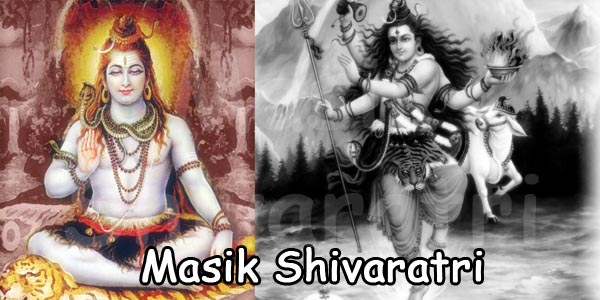OM NAMAH SHIVAYA! This chant is rendered loud and clear at the time of Shivaratri. Lord Shiva is well known for his strength and valor. Lord Shiva has many names, 108 names to be precise, but apart from Shiva, the name of Bholenath is quite popular in North India. Shivratri festival epitomizes the fusion of Lord Shiva with Shakti – which is strength. The word masik means monthly and during Krishna Paksha the Chaturdashi Thithi is none other than the Masik Shivaratri.
Although Masik Shivaratri comes every month on Chaturdashi Thithi, it the one that comes in the month of Magha that makes it the most crucial one called as Maha Shivaratri as per the diktat of the Amavasyant School. In contrast to this, when Masik Shivaratri comes up in the month of Phalguna, the Purnmant School considers this to the actual Maha Shivaratri. Having said that, one should keep in mind that the difference lies in the lunar month nomenclature whereas the day and date are actually the same for both the schools in the case of Maha Shivaratri celebration every year.
As per Hindu mythology, the legendary story for celebration of Maha Shivaratri states that Lord Shiva took the form of a Linga on that day hence it is called as Shiva Linga and is considered as the birthday of Lord Shiva. It is said that the first two divine lords to have worshipped the Shiva Linga are none other than Lord Vishnu and Lord Brahma. Devotees across the country celebrate Maha Shivaratri with great fervor and worship the Shiva Linga on the day. Many devotees do the Shivaratri Vrat which has been a practice since ancient times as per records mentioned in the Hindu Puranas.

Even Goddesses such as Lakshmi, Saraswati, Gayatri, Indrani, Savitri, Sita, Parvati and Rati have been known to keep the Shivaratri Vrat and fast throughout the duration of Maha Shivaratri in dedication towards Lord Shiva. Staunch devotees looking to observe the fast every month on Masik Shivaratri may do so by beginning the fast on Maha Shivaratri and then continue it once every month for the entire year. By doing so, devotees believe that the impossible turns into possible by removing all obstacles and fulfilling ones wishes. For Shivaratri, the devotee must remain awake and not sleep. At the stroke of midnight, the Shiva Puja to the Shiva Linga should be done with utmost devotion. This fasting and worship ritual is more popular among women as the unmarried women are blessed for getting a good life partner in marriage whereas the married women do so for blessings to have a happy and prosperous married life. Although Maha Shivaratri day is always auspicious it is all the more so when it falls on a Tuesday. The most auspicious time for Shivaratri worship and Puja is at midnight generally referred to as Nishita Kaal which lasts for two Ghatis. Our website furnishes information on the exact muhurtam time for Nishita Kaal muhurtam so that devotees get to know when to perform the Shiva puja during Masik Shivaratri and Maha Shivaratri. Tuesday is the most auspicious day for Masik Shivaratri and when these two coincide, devotees of Lord Shiva consider it as positive.
